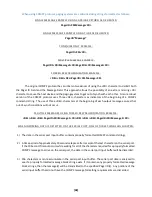
[48]
When using COMP2 protocol, paging systems are controlled using strings formatted as follows:
SINGLE MESSAGE EXAMPLE USING CARRIAGE RETURN AS DELIMITER:
PagerID<CR>Message<CR>
SINGLE MESSAGE EXAMPLE USING TILDE AS DELIMITER:
PagerID~Message~
TONE/VIBE ONLY EXAMPLE:
PagerID<CR><CR>
MULTIPLE MESSAGE EXAMPLE:
PagerID1<CR>Message1<CR>PagerID2<CR>Message2<CR>
FORCED RESYNCHRONIZATION EXAMPLE:
<DEL><DEL><DEL>PagerID<CR>Message<CR>
The original COMP2 protocol has an inherent weakness of using the <CR> character to delimit both
the Pager ID Field and the Message Field. This approach allows the possibility of an extra or missing <CR>
character to cause the host device and the paging system to get out of synch with each other. A more robust
version of the COMP2 protocol uses Three <DEL> characters as indicators of the beginning of a COMP2
command string. The use of three <DEL> characters at the beginning of each output message assures that
out-of-synch conditions will not occur.
MULTIPLE MESSAGES USING FORCED RESYNCHRONIZATION EXAMPLE:
<DEL><DEL><DEL>PagerID<CR>Message 1<CR><DEL><DEL><DEL>PagerID<CR>Message 2<CR>
WHEN INCOMING DATA IS DETECTED ON THE SERIAL PORT, ONE OF THREE THINGS WILL HAPPEN:
1)
The data in the serial port input buffer contains properly formatted COMP2 command strings.
2)
A time period of approximately 10 seconds elapses after receipt of the last character on the serial port.
If the 10 Second Timeout occurs while waiting for all of the characters required for a properly formatted
COMP2 message to arrive on the serial port, the data in the serial port input buffer will be discarded.
3)
256 characters or more accumulate in the serial port input buffer. The serial port data is analyzed to
see if a properly formatted message block string exists. If it contains any properly formatted message
block strings, then the message(s) will be transmitted to the specified Pager ID(s). Any portions of the
serial input buffer that do not have the COMP2 message formatting requirements are discarded.







































